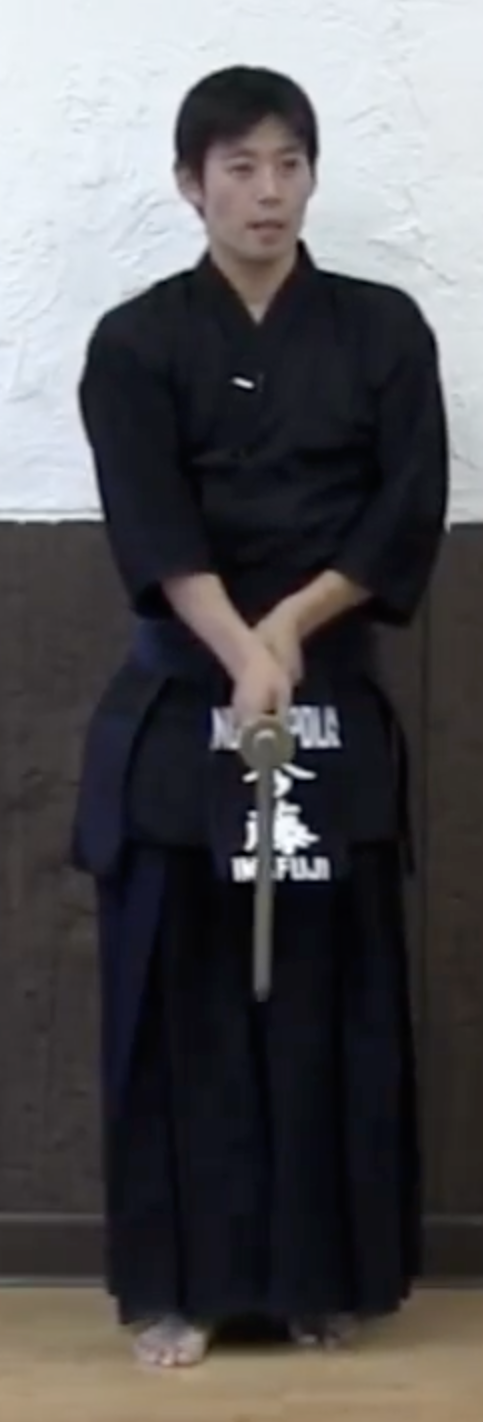You Got It!
Kendo Kata: Sanbon-me
Kendo Kata Sanbon-me is not as easy as Kata No.1 and No.2.
First, I will explain the meaning of Kata No.3. Knowing the meaning may help you to remember what's going on.
Meaning of Kata No3
 Kata No.3 Gedan
Kata No.3 GedanIn Kata No.1, shitachi kills uchitachi and in Kata No.2 shitachi cuts off the right wrist of uchitachi. But in Kata No.3, shitachi doesn't kill uchitachi or doesn't hurt uchitachi at all.
In Kata No.3 no one gets killed or hurt, but uchitachi and shitachi live together without hurting each other. Shitachi doesn't even have intention to kill or hurt uchitachi.
According to Inoue sensei,
"No one gets struck or strikes. Even though there are obvious victory and loss, the winner doesn't brag about his/her victory and both winner and loser take care of their lives and live together. This is kendo and the goal of training kendo. That is why kendo is different from sport" (the quote from p. 199 from "Kendo Seidan 3", 1993 translated by Masahiro Imafuji).
Obviously this is a combat. This is a fight. But you don't have to kill or hurt others, if you are strong enough. This is Kata No.3 and the goal of kendo.
Here is What Happens in Kata No.3
|
Uchitachi |
Shitachi | |
|
1. |
Take gedan |
Take gedan |
|
2. |
Take three big steps forwards onto the front foot. |
Take three big steps forwards onto the front foot. |
|
3. |
Start moving the sword up to chudan. |
Start moving the sword up to chudan. The sword is slightly under the sword of uchitachi. * This indicates that shitachi's ki is stronger than that of uchitachi, so uchitachi cannot stand the pressure of shitachi. |
|
4. |
Come to the chudan level. |
Come to the chudan level. |
|
5. |
Execute a thrust into suigetsu (solar plexus) of shitachi turning the sword counter clockwise, (i.e. the blade of the sword is facing to the right). |
Execute nayashi taking a step backwards onto the left foot to parry the thrust of uchitachi. * Don't push down the sword of uchitachi when you execute the nayashi. And execute a thrust aiming at the chest area taking a step onto the right foot. |
|
6. |
Take a step backwards onto the right foot lowering the sword, and lift it up around the sword of shitachi to block the thrust of shitachi. The blade is slightly facing down to the right when blocking the thrust of shitachi. |
Take another step forwards onto the left foot. This is NOT another thrust. Keep the sword where it is and push uchitachi back. |
|
7. |
Take a step backwards onto the left foot lowering the sword, and lift it up around the sword of shitachi to keep the sword off the centre. |
Take 3 more steps forwards onto the right foot after pushing uchitachi back at the second step. This is called "kurai-zeme", attacking your opponent without executing strikes but with putting pressure on your opponent. On the first step of the last three steps (i.e. the third step from the very first thrust that shitachi executes), the sword is still pointing at around the chest area of uchitachi. On the second step, the tip of the sword is pointing at around the throat area of uchitachi. On the third step, the tip of the sword is pointing at around the bridge of uchitachi's nose. |
|
8. |
Take three more steps backwards onto the left foot. Lower the sword to the right to show the loss of uchitachi after the second block. Tricky Part: The first step backwards is from the right foot. The second step backwards is from the left foot. And the third step is from the LEFT foot. |
Show zanshin. |
|
9. |
Start moving the sword up after shitachi shows zanshin. |
When uchitachi starts moving the sword up, carefully start taking five steps backwards onto the left foot. |
|
10. |
Start moving forwards to follow shitachi onto the right foot, when shitachi takes the third step backwards. | |
|
11. |
Back to the centre in chudan. |
Back to the centre in chudan. |
|
13. |
Kamae wo Toku: Lower the sword turning it to the right so the kensaki of your swords is approximately in front of your right knee. |
Kamae wo Toku: Lower the sword turning it to the right so the kensaki of your swords is approximately in front of your right knee. |
|
14. |
After the five steps, take chudan and ready for Kata No.4. |
After the five steps, take chudan and ready for Kata No.4. |
